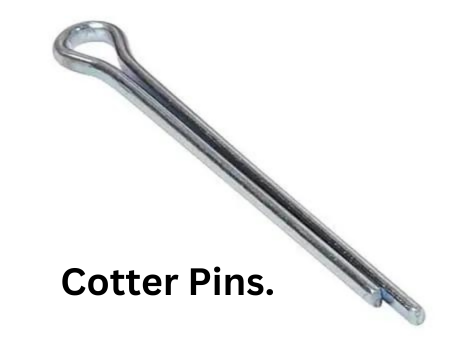Define the Cotter Pins:
A cotter pins is a wedge or pin that is used to temporarily secure components by inserting it through holes that are aligned. The cotter pin is also referred to as a split pin or cotter key in the United States. The thick wire used to make the split pin, also known as cotter, has a semicircular cross section.
To prevent it from coming out, the pin is bent after being inserted into the exact holes in the components. Cotter pins come in a variety of sizes and designs.
These pins are typically used to halt axial motion along the shaft. The wedge-shaped or tapered pins are inserted into the holes.
The word “tapered” describes how the pins shrink as they go through the holes. Friction is created when the pin compresses, keeping it from loosening and facilitating smooth operation.
Cotter pins are frequently used to fasten various components in mechanical and engineering systems. The most popular use for these pins is to secure bolts, clevis pins, and other fasteners that could come loose due to vibration or movement.
Process of the Split Pin:
The locking mechanism is operated upon by the cotter or split pin. It is useful for many different things. All you need to use these simple fasteners are pliers, a castle nut, and a drilled bolt (if the bolt isn’t already drilled).
Without a hole, cotter pins cannot be inserted. With it, a multitude of tasks can be completed. To make these fasteners during installation, you’ll need pliers, a castle nut, a drilled bolt, and pliers.
To use the cotter pins, just thread it through the bolt’s hole. The cotter pin’s prongs should be twisted, then turned outward and apart from one another. Despite the common belief that cotter pins work best when twisted together, when twisted apart, these straightforward fasteners provide the best protection against loosening. When the cotter pin is used in this manner, the possibility that the bolt will come loose as well is decreased.
Cotter Pin Types:

Cotter pins in the following varieties: split, R-pins or R-clips, standard, spring, barrel, dipper, straight, and cotter pins with a key. most popular varieties of cotter pins.
Divided Cotter Pins:
Perhaps the most common kind of cotter pins are split cotter pins. The semicircular wire used to make these pins is bent over the flat side to create the bulbous heads. Split cotter pins are fastened with a deformable tine in pre-drilled parts. They are only useful in one-time situations and also serve as a brake for the clevis pin. Depending on how the wire is bent and connected, split cotter pins come in a variety of designs.
R-Pins:
The straight portion of the R-pins goes through a hole in the shaft, which holds the pin in place, while the bowed portions are clamped on the outside of the shaft. For convenience of use, you can insert your finger into the ring on the head of the pin and pull it out of the hole.
Cotter Pins for Barrels:
Barrel cotter pins have a cylindrical shape and two distinct ends: a long side and a short side. These pins can be used to create threaded joints that connect threaded pipes and hoses. It can be used, for instance, to join two hoses or pipes.
Cotter pins that are straight:
Straight cotter pins resemble cylinders in appearance as well, but they only have one round edge. On them are straight ends. Its ends are not rounded or curved. Straight pins like these are ideal for fastening objects that move a lot because they don’t easily come loose.
Typical Cotter Pin:
These cotter pin kinds come in both straight and curved designs. It connects to other parts through the hand with good grip thanks to its large surface. There are two distinct ends to a standard pin.
The pins are connected to each other by one end.
The pin is connected to an object using its second end.
Cotter Pin in Spring:
A spring inside the spring cotter pins aids in creating tension force for increased grip strength. This pin is typically used on hoses and pipes, which frequently rotate or move suddenly, or in other situations where there is no other way to apply the necessary pressure to the object.
Cotter Pin for Barrels:
The barrel cotter pin resembles a cylinder with two distinct ends, one short side, and one long side. Its sides are rounded. When connecting two hoses or pipes together, for instance, this kind of pin is used for threaded joints.
Cotter Pin Dipped:
The cotter pin that has leaked has two ends:
there’s a hole in the flat head on one end.
The other end is shaped like a “T.”
The most typical use for these kinds of cotter pins is to guarantee that the dust cap is tightened onto a mandrel that encircles the engine shaft.
Airtight seals are created between the capped-off area and other parts when the dipped cotter pin is installed.
Parts and Construction of the Cotter Pin:
The new cotter pin has a split appearance because its inner flat surface touches its length. The pin flexes on both edges as it is inserted, locking it into place. Flex fatigue will occur as it removes; as a result, you will need to replace and discard the pin.
Although it is not advised to use pins to withstand strong shear forces, the soft metal used in their construction allows for easy installation and removal of the pins. Split pins are made from materials like brass, mild steel, stainless steel, aluminum, or bronze.
A Clevis Pin: What is it?
With a clevis and a clevis pin, a clevis fastener is a two-part fastening system. This clevis is U-shaped and has a hole at the end of the prongs for the clevis pin to slide through. Though they have cross-holes for split pins and are either slightly threaded or unthreaded, these pins resemble bolts.
The clevis pins can be used to secure the tang in place after it has been installed in the clevis gap. A shackle is commonly defined as a basic pin and clevis combination; however, there are numerous other variations of the shackle.
These pins find application in a range of fasteners within the aerospace, locomotive, and construction sectors, as well as in marine equipment and agricultural machinery. In airworthy model aircraft, the clevis pin is also used to connect the control surface and other components to the servo controls.
(FAQs)
Are cotter pins reusable?
A wide range of sufficiently bendable materials can be used to create split pins. Once deformed, deformed pins typically maintain their strength and offer a dependable and potent locking mechanism.
In general, cotter pins cannot be reused. It’s because the pins become weaker when they bend. In this instance, the nut may begin to spin loosely due to the pin failing.
What is the function of Cotter Pins?
Coater pins are fasteners that are used to attach screws to nuts. The bolt must have a tiny hole drilled in it before a pin can be used.
for more information visit our Homepage.






